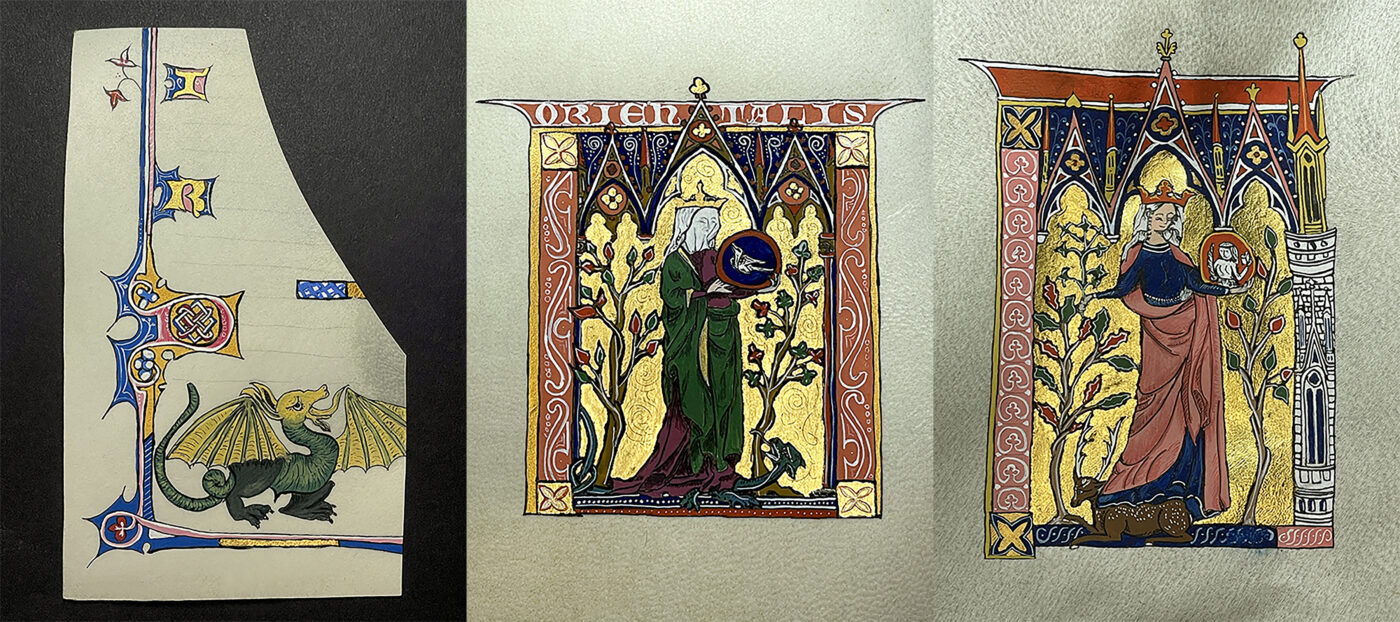- Item: A Page in 5 Parts
- East Kingdom Wiki Link: https://wiki.eastkingdom.org/wiki/Aaradyn_Ghyoot
- Reference Manuscript: http://www.bl.uk/manuscripts/FullDisplay.aspx?ref=Add_MS_28162
- My blog: https://aaradyn-ghyoot.blogspot.com/2023/10/humilite.html
In 2018 I embarked on a project to understand how vellum worked as a ground, how the materials I was already very familiar with worked on the most used ground in period, and how my process would have to change to work with this new material. I chose a source with a most excellent carpet page, and one that would be easy to do in parts: Add MS 28162, The Somme le Roi, a moral compendium compiled in 1279 for King Philip III of France. A beautiful French manuscript with heavy gold work. The finished project will be the Vellum Dragon and four separate images, each a “complete” panel as though the panels were individual images.
The first in the series isn’t from my source page, but instead is from Yates Thompson MS 13, a manuscript created in the 2nd quarter of the 14th century. I call this one “the Dragon at the End of this Manuscript” or Vellum Dragon for short. The first piece I’d ever done on vellum, I left space for the calligraphy but did not fill that in. My focus for these pieces is the illustration and gilding. On this piece I did a small section of gold leaf, and the rest in shell gold gouache. It was with this piece that I learned how vellum swells when you apply paint that is too wet, and how drawing back up some of the paint with your brush can reduce the swelling, and it will lay flat again easily. When doing white work overtop of paint applied to vellum, the paint doesn’t rehydrate as easily as it does on pergamenata, and your white work goes on more cleanly. For a piece of scrap vellum, I was very happy with this piece and this inspired me to begin the project in earnest.
The first image is from Add MS 28162 f6v, a carpet page (a page of just illumination) of four panels each depicting a different facet of moral behavior. The manuscript size, thanks to the clarity of the British Library manuscripts database, is 255 x 185mm, with a text size of 165 x 125mm. As I learned from doing 1:1 scrolls, painted size isn’t always text size, and here is no different. The painted size is slightly larger than the text area, but as I wasn’t doing a complete page but instead each of the panels as individual images, my math was a little more nebulous. The finished size for each of my pieces is roughly 3.5” x 4”. Page size varies depending on the vellum piece. The vellum here is goat skin, and I prepared it with a white Staedler eraser. The panel for the first piece is Ammitie, or Friendship in modern English. The virtue depicted was not the goal for me, so instead I created this piece as Orientalis, or “belonging to the East”. The Lady is veiled, and so could be any Rose of the East, and holds a plate with a dove, a symbol of peace and grace. She is clothed in the colors of the East, Purple and Green, and the plate backing in Blue, a nod to our populace badge. She stands on a Dragon, but the Dragon is not injured, honoring the Yearly Enemies/ Eternal Friends bond we hold with our neighboring kingdoms. This was my first experiment with tooled gold, and while it is possible without doing raised gold (that is, gold with gesso underneath it), it isn’t as impactful. It’s not as visible here as I would have preferred. I am very happy with the rest of the piece, and remain solid in my opinion around whitework on vellum – it is so much easier. This was done in February of 2019.
Image two is from f5v, the panel depicting Humilite, or Humility. I intended this piece to be Humility, as the original, because it’s an important reminder as our skill grows in the arts. This piece is mostly finished, save for the title at the top. The vellum for this piece is also goat, and was prepared the same way as before. The gold here isn’t raised or tooled, but instead is painted to see if that was the method they used. I found out that, in fact, it isn’t. I don’t think the gold was raised, but I know it was tooled. I suspect two layers of gold were used, one painted and then the gold leaf applied over top. I’ll be using that method on my next piece. Here, the woman is clothed as she is in the original manuscript, save the lining for her cloak. My blackwork here is a little messy, and I suspect the issue is the consistency of my paint. Ultramarine was also too dark for her dress, and some detail is lost. I rushed doing the whitework lettering at the top, and removed it as it smeared with the orange beneath it – I will likely not finish this piece though… The page got wet through some clumsiness on my part and is badly wrinkled now. I was going to try to flatten it, but I will leave it as it is and start the next piece once the rush of the holidays is over. The page will serve as a reminder to be careful around your rinse water! 😉 This was done over the course of 2020.
I intend to pick this project back up in 2024.
Additional Pictures of All Pieces: https://drive.google.com/drive/folders/1IfB0nEGqoILyWxSWUKrn1Nk3EwMlWRxt?usp=sharing

Thank you for sharing your journey and all you learned! Your art is amazing, so beautiful!